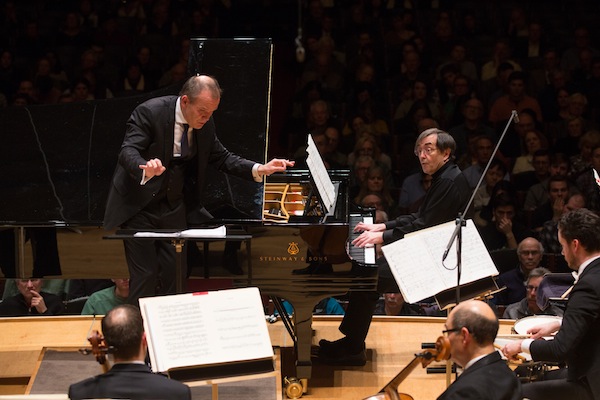Roth brings elegance and intensity to BSO program

Pierre-Laurent Aimard performed Bartok’s Piano Concerto No. 1 with François-Xavier Roth and the Boston Symphony Orchestra Thursday night at Symphony Hall. Photo: Robert Torres
First works rarely find a place in the repertoire. And while interesting to the historian, pieces like Richard Strauss’ Festmarsch and Schoenberg’s early piano miniatures don’t often find an audience these days.
But with Webern the trend seems to be the opposite. His early music is still widely played and it shows a musical mind experimenting with form and a chromatic, though romantic, musical language. His Passacaglia, Op. 1 was once a regular item on concerts of the Boston Symphony Orchestra. Curiously, this attractive piece hasn’t been heard on BSO programs since 1980, and the orchestra hasn’t performed any of Webern’s music since 1995.
Thursday night François-Xavier Roth brought renewed attention to the Austrian composer through a surging and intense performance of the Passacaglia alongside music by Bartók and Stravinsky.
Webern’s score, which spans just twelve minutes, was the composer’s “graduation piece” after his studies with Schoenberg concluded. Roth delivered a reading that was well attuned to the piece’s romantic roots.
The French conductor conjured technicolor details from the score without relying on an extravagant podium presence. Leading without a baton, his gentle hand waves seemed to caress the music as it floated by, and sudden lunges brought out wide crescendos. The orchestra responded with beautiful playing. Winds and harp created feathery textures, and a muted trumpet sounded at a haunting distance. Phrases, too, had an elegant vocal shape. This was Webern in which to revel, and one hopes his music returns to the BSO’s regular programming in the future.
The most bristly work on Thursday night’s modernist program was Bartók’s Piano Concerto No. 1, played with power and fluency by French pianist Pierre-Laurent Aimard.
With its folk-laced melodies and biting harmonies, the work has a propulsive rhythmic drive. But there’s a hint of Bach running through the concerto, and its fugal sections weave lines together in a fine musical fabric.
Aimard is well known for his performances of modernist pieces, and his approach to this concerto didn’t always result on crash-and-bang sonorities. His smooth, resonant tone found a hidden lyricism in the cluster chords that dot this glittering work.
The second movement was mysterious. Built from a three-note motive that resembles the opening to Beethoven’s Fifth Symphony, the movement progressed from shimmering chords to a stabbing waltz. Through it all, Aimard played with a keen sense of the musical line.
Aimard delivered a fiery performance of the outer movements, the cascading figures sounding with crystalline precision. Roth’s accompaniment supplied a colorful backdrop with fine contributions from the woodwinds in the solo passages.
Roth has a fine sense of large works, and after intermission he led a bracing account of Stravinsky’s complete score to The Firebird.
The beloved work is a marvel of orchestration. Roth kept an eye to the intricacies of the piece and drew out svelte solos. John Ferrillo’s oboe phrase hung in the air like a weeping willow, and Richard Svoboda’s bassoon line in the Lullaby had the warm sound of a chant. James Sommerville’s French horn call in the Finale seemed to sound out from the mist.
Elsewhere, Roth’s reading found the music’s driving intensity. The Infernal Dance was an aptly hellish scene, full of zeal in its whip-crack pace. Bold chords in the Finale put the finishing touches on this memorable performance.
The program will be repeated 1:30 p.m. Friday and 8 p.m. Saturday at Symphony Hall. bso.org; 888-266-1200
Posted in Performances




